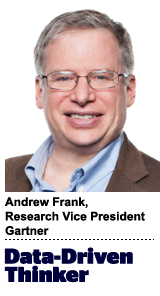 “Data-Driven Thinking” is written by members of the media community and contains fresh ideas on the digital revolution in media.
“Data-Driven Thinking” is written by members of the media community and contains fresh ideas on the digital revolution in media.
Today’s column is written by Andrew Frank, research vice president and distinguished analyst at Gartner.
Ever since the ad industry made “creative” a noun, agencies and creatives have defended its mystique against an onslaught of data-driven optimization.
Effective creative is forged from empathy and storytelling skills, the argument goes, along with humor, passion and other qualities beyond the reach of algorithms. Dynamic creative optimization (DCO) and personalization engines might help optimize the selection and assembly of creative elements, but the most effective ads still rely on the human touch.
The numbers back this up. Evidence that creative contributes more to the success of an ad than media elements such as targeting and reach has accumulated for years. Data-driven media optimization has moved the needle a bit, but most research still favors creative’s influence. In 2006, for example, Nielsen Catalina Solutions found that media contributed 15% to ad effectiveness, compared with 65% attributable to creative quality. In 2017, it found that media’s contribution had risen to 36%, while creative dropped to 49% – still the largest factor. And within media, targeting only contributed 9% – reach (22%) and recency (5%) accounted for the rest.
Recently, we’ve seen evidence that marketers are taking this to heart. After years of investment in programmatic audience targeting, marketers are turning to DCO and personalization technologies in their quest for better performance. A recent survey by Sizmek found that 79% of marketers are prioritizing the need to “increase our use of DCO” in the next 12 months.
DCO itself is evolving from template-based enablers of product-specific retargeting banners. Not only are its rules becoming more sophisticated, but machine learning is taking over the “optimization” part. New platforms are looking at ad creative as part of a broader narrative of customer engagement, with full-funnel scope, higher-level values and long-term implications.
Programmatic media platforms first injected AI into the advertising market, but creative is its next frontier. This vision is being reinforced by marketing cloud vendors extolling the benefits of their personified AI features, including Sensei and Einstein, which can automatically personalize content, if not create it. Serving up every aspect of the buyer journey in a personalized manner is what customers now demand and luckily, the technology is catching up.
I see a few factors driving this technology adoption. First, privacy concerns are starting to erode direct audience targeting tactics. As walls go up around consumer behavioral data, contextual targeting and engaging content will need to play a bigger role in overcoming ad avoidance and low receptivity trends. Vendors are deploying computer vision to identify the most compelling ad placement opportunities, with some notable results.
A/B testing is also hitting its limits for personalized creative testing. Setting up and executing an effective A/B test is time-consuming and costly. Automation can scale this up dramatically. Algorithms such as contextual bandits can optimize the tradeoff between testing new experiences and delivering the ones that have proven effective, which makes continuous testing of thousands of variants practical.
Meanwhile, AI can accelerate and scale the creative process without replacing humans. Although they exist, robot copywriters (and creative directors) are much less likely to displace creatives than they are to amplify their productivity and effectiveness. This is often called the centaur model of human-machine collaboration. Smart creatives will learn how to work with AI before their managers try to make them.
And finally, marketers are discovering the value of adaptive branding. Challenged by direct-to-consumer competitors and brand-indifferent search engines, marketers often turn to sales promotion tactics like retargeting, which are much more easily measured and optimized than brand advertising. Others, suspicious of the longer-term costs of short-term incentives, have doubled down on old-fashioned, broad-reach media. But innovators are discovering how to personalize their brand messages using the techniques and technologies of creative optimization and generation.
To make the most of these new creative technologies, marketers and agencies will have to make some impactful changes. These include the de-siloing of media and creative disciplines (and agencies) and learning how to integrate technology into a creative culture that’s far more distrusting of numbers and formulas than media.
But transformation is inevitable: Data-driven thinking beats pure intuition nine times out of 10.
Follow Gartner (@Gartner_inc) and AdExchanger (@adexchanger) on Twitter.
This post was syndicated from Ad Exchanger.


More Stories
Warner Bros. Discovery CEO David Zaslav Receives $51.9 Million Pay Package for 2024
TikTok Fave Duolingo Boosts YouTube Shorts Viewership 430% in One Year
Streaming Ratings, Week of March 10: Disney+ Sails to the Top Courtesy of Moana 2